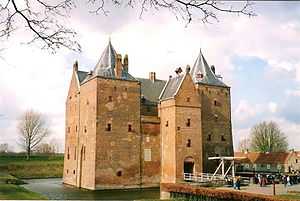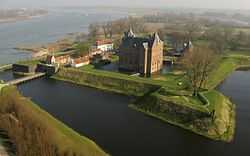Loevestein
| Slot Loevestein | |
|---|---|
| Poederoijen, the Netherlands | |
 | |
| Slot Loevestein | |
 | |
| Coordinates | 51°48′59″N 5°01′17″E / 51.8164°N 5.0214°E |
| Type | Castle |
| Site information | |
| Open to the public |
Yes |
| Condition | Good |
| Site history | |
| Built | 1361 |
| Built by | Dirc Loef van Horne |
Castle Loevestein (Slot Loevestein in Dutch) is a medieval castle built by the knight Dirc Loef van Horne (hence "Loef's stein" ((stone)) house) between 1357 and 1397.
Until the Second World War Loevestein Castle was part of the Nieuwe Hollandse Waterlinie, the main Dutch defense line that was based on flooding an area of land south and east of the western provinces. Currently the castle is used as a medieval museum and function centre.
History

It was built in a strategic location in the middle of the Netherlands, where the Maas and Waal rivers come together (just west of current day villages Poederoijen and Brakel, in the municipality of Zaltbommel, in Gelderland). At first it was a simple square brick building, used to charge toll from trading vessels using the rivers. In the 16th century (around 1575, orders given by William the Silent) it was expanded to a larger fortress surrounded by earthen fortifications with two (later three) stone bastions on the northern side, two moats, an arsenal, and housing for a commander and soldiers.
It changed hands twice between the Northern Dutch and the Spanish (December 9, 1570 it was taken by the Geuzen, ten days later Spanish again, and from June 25, 1572 Dutch till this day), the warring parties of the day. The castle soon (from 1619) became a prison for political prisoners. One famous inmate was the eminent lawyer, poet and politician Hugo de Groot (Hugo Grotius) often presented as the "father of modern international law", who was serving a controversially imposed life sentence from 1619.[1] In 1621 Hugo de Groot managed to pull off a daring escape in a book chest. The idea for this escape came from his wife Maria van Reigersberg (also living in the castle).[2] He subsequently became the Swedish Ambassador to France for 10 years. Another high profile inmate was the English Vice-Admiral George Ayscue.
In literature
In Alexandre Dumas, père's La Tulipe Noire, the main character Cornelius Van Baerle is imprisoned at Loevestein.
See also
Gallery
-

Gunpowder tower at castle Loevestein.
Source
- Kransber, D. & H. Mils, Kastelengids van Nederland, middeleeuwen, Bussem 1979 (ISBN 90 228 3856 0)
- Kalkwiek, K.A., A.I.J.M. Schellart, H.P.H. Jansen & P.W. Geudeke, Atlas van de Nederlandse kastelen, Alphen aan den Rijn 1980 (ISBN 90 218 2477 9)
- Helsdingen, H.W. van, Gids voor de Nederlandse kastelen en buitenplaatsen, Amsterdam 1966
- Tromp, H.M.J., Kijk op kastelen Amsterdam 1979 (ISBN 90 10 02446 6)
References
- ↑ Murray, John (2009). A hand-book for travellers on the continent: being a guide through Holland, Belgium, Prussia. BIBLIOBAZAAR. p. 73. ISBN 1-117-07017-4.
- ↑ Davies, Charles Maurice (2010). 's+idea+escape&hl=en&ei=PaxXTpHlDvPQ4QTVwZ29DA&sa=X&oi=book_result&ct=book-preview-link&resnum=4&sqi=2&ved=0CDYQuwUwAw#v=onepage&q&f=false539 History of Holland, from the beginning of the tenth to the end of the Eighteenth Century, Volume 2. General Books. p. 539. ISBN 978-1-151-01164-0.
External links
| |
Dutch Rijksmonument 10081 |
-
 Media related to Loevestein at Wikimedia Commons
Media related to Loevestein at Wikimedia Commons - Loevestein Castle home page (Dutch)